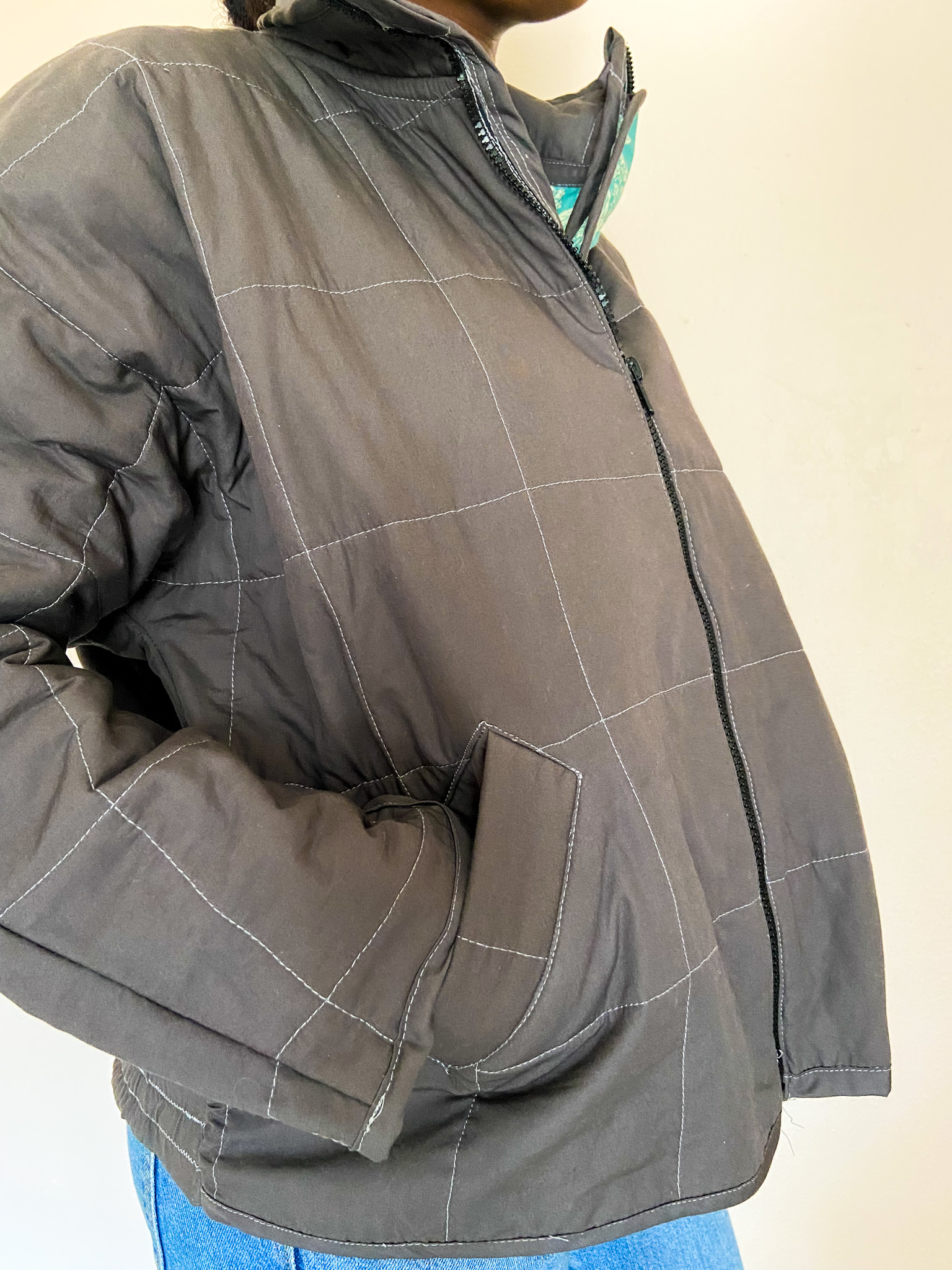
I don’t know if you’re like me, but sometimes it takes a while to start a new sewing project after I’ve finished the last one and there are various reasons for that. But regardless, we start again.
This was my only fall project for 2024 and honestly, I’m okay with that because this one ended up being quite a task.
There were two things I wanted for this next project.
- I wanted to make a jacket
- I wanted to make it quilted
Here we go on the journey toward a new jacket.
This project was a challenge. Mainly due to this including many firsts:
- First jacket
- First quilted item
- First (technically second, but first to this extent) DIY bias tape
Pattern
Let’s start with the pattern.
I scoured Pinterest looking for patterns then went to Etsy. These are usually my two first places to look.
This is the pattern I chose.

It’s the Grace Dolman Quilted Jacket pattern from kdornbierdesigns.
I was looking for a quilted jacket pattern that seemed relatively simple.
Here’s why I chose this pattern:
- There was a simple quilted pattern. This was perfect for my first time.
- The style of the jacket was light-mid weight which I loved.
- I appreciated the zip and side pockets.
The one style detail I wasn’t a huge fan of when initially looking at the pattern was the elastic in the back at the bottom. I still chose to use this pattern and sew it as is just to see the final outcome.
Fabric Choice
Alright, so now that I’ve chosen the pattern, the next step is choosing the fabric.
I did a little bit of Pinterest research to find the best fabric options. Cotton is the best for quilting items and works for the jacket as well.
When searching for options, I went about it like a quilting project in that I choose the outside fabric, lining fabric, and cotton batting for the middle.
There are some online fabric stores I searched through. Ultimately, I chose to purchase from PearTreeMarketDotCom on Etsy. They have a standard website here, but since I originally found them on Etsy, that is where I decided to purchase.
The outer fabric is Magnetism by Art Gallery Fabrics. I love the soft texture of this fabric and the color was a perfect slate gray–not too light and not too dark. This is also the fabric I used for the bias binding.
The lining fabric is Verbena Watercress by Ruby Star Society Fabrics. I wanted a print inside for a fun surprise and this worked perfectly. It has a light-medium shade of teal background with cream flowers.
The batting is Natural Cotton Batting from Pellon.
Now that we’ve gotten all of the fun sourcing out of the way, let’s get to constructing the jacket.
When looking at quilting information, I saw that it was recommended to get a walking foot for smoother sewing. So, I took the advice since I would be sewing through a lot of layers.

Cutting
Something different with this pattern that is not like others is that the creator prioritized low waste, so the fabric was not folded to cut the pattern pieces.
The cutting layout provided by the creator was to simply open the fabric so it is a single layer and cut the pieces.
Quilting
As I previously mentioned, this was my first quilting project. The quilting pattern on this was simple. The pattern included a simple block quilting pattern to trace and sew over.
This was a relatively simple process. The layers were the outside fabric, the batting, and the lining fabric. When the layers were quilted together, each piece acted as one piece that was three layers.
Garment construction
The construction steps were pretty straightforward and standard in the sewing process. The pattern designer wrote easy to understand steps with a lot of tips and hacks included.
Personal Challenges
These are the areas in which I had the most challenges.
Bias Binding: this was my second time creating my own bias binding and my first time using the method that was included in the pattern instructions. My bias binding did not come out as nicely as I would have liked. I will practice the method again in the future.
Because the bias was not created as great as I would have liked for it to, attaching the bias to the garment was challenging.
Back elastic hem: I was already skeptical about including this simply from a design perspective. Creating the individual stitches through the width of the back band presented challenges for me. I encountered a couple of tension issues. If I choose to sew this pattern again, I will most likely leave this out and sew a regular hem.
Thick layers of fabric: This was something that the pattern designer stated and was already known prior to me starting the projects. There were multiple steps throughout the process where six layers of fabric were sewn together (two 3-layered quilted pieces). This required sewing very slowly and adjusting tension levels. The walking foot definitely helped; however, it still caused challenges.
Final Observation
Overall, I really enjoyed this pattern and am satisfied with the final outcome. There were definitely hiccups due to there being a lot of firsts for me, but the final jacket is great.
The pattern instructions were very well written and I will definitely look toward creating more projects from this designer.

